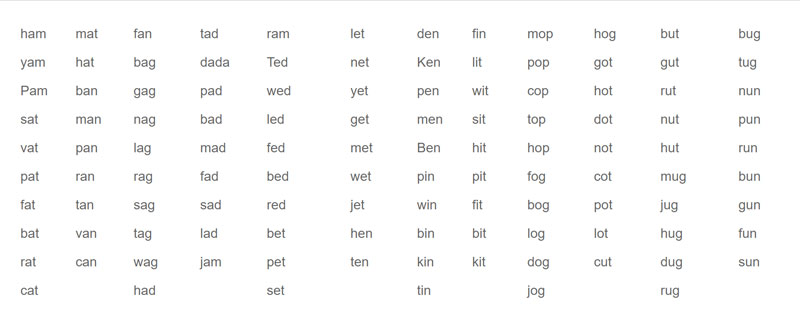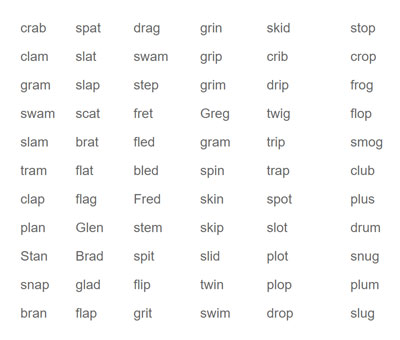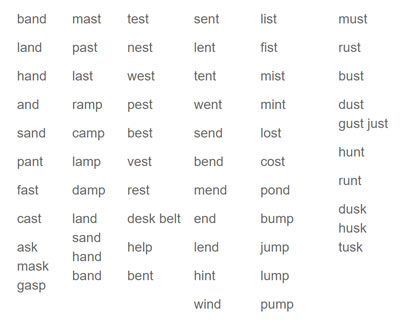Learn at Home Activities for Word Reading
CVC refers to the consonant, vowel, consonant pattern seen in words like sun, pen, man and hit. This is often referred to as the ‘basic code’ in reading instruction. Basic code refers to the one-to-one relationship between one letter and one sound. The most common sounds for letters are used and the vowels make the short sound. For example, even though the letter “s” can be the sound /z/ in was or has, its basic code sound is the sound /s/. Reading phonetically is referred to as ‘decoding’, so we start by decoding the most basic sounds and combinations of sounds. This is the foundation; students need to feel successful attacking 3 letter words in order to feel confident and apply this skill with new words and in new text.
Activities for Decoding CVC Words
Model: Show the letters moving together while you model blending the sounds together and select the picture of the word that the sounds represent as you blend the sounds faster and eventually say the word. This helps learners understand the concept.
Support: After modeling, have your child practice blending the sounds you say. In this video, the Sesame Street monsters are demonstrating blending a beginning sound onto a word ending, which can be a good place to start if your child is having difficulty blending three sounds together. Just as the monsters demonstrated their understanding of the word sad, we need to give our learners the opportunity to show that they have made meaning from blending the sounds in the word. Giving two or three pictures to choose from (as shown in the photo below) allows your child to connect the word they have read with its meaning.

Read: Write or build one of the words and have your child say each sound and blend to read the word, then choose the picture card to match what they have read. There are many worksheets available that are like this, but I find it useful to use larger picture cards and movable letters to really be able to demonstrate what we are doing (ie: point to each letter as you/ they say the sound, display letters further apart as you segment but move them together as you blend, physically pick up the card and match to the word rather than drawing lines (which may add unnecessary difficulty to the activity). We have provided slides (near the end of the PowerPoint) with three CVC pictures on each so you have pictures of CVC words for your child to choose from. These can also be printed and cut apart, which may be necessary to target specific skills (discriminating between similar vowel sounds, for example). Click here to download and print
These blending envelopes are useful for learners who tend to look at the first letter and guess the word: the activity shows them how to look at each letter and say its sound one at a time. Model and have them practice blending the first two sounds before showing the third sound to be added. Here is the link to the short e cards; the rest of the vowels are linked at the end of the post.
If your child is confidently and independently blending CVC words, have them try words with consonant digraphs such as ch, th, sh (be sure to present as one unit since the two letters work together to make one sound) and consonant blends such as fl, tr, br, st at the beginning of words and then at the end.
Free Decodable Books Online:
- Progressive Phonics – Downloadable books that provide a shared reading opportunity – you read most of the text and your child reads the CVC words indicated in red.
- SPELD Phonics Books
- The Reading Genie – Books written by teachers using PowerPoint
- Fun Phonics
Decodable Word Lists:
Below are lists of words that follow specific patterns in progressively more difficult order. The list is nice to keep handy when working on spelling and reading words with your child. It is also useful when you are trying to write decodable sentences or books for your child to read. Some children are not motivated to read decodable books like the ones listed above. I often create decodable books using the child’s interests (favourite characters from TV and movies, animals, vehicles etc.). You can do a Google search for a picture and create a simple sentence to go with it. No need to print anything; just show the picture and write the sentence on a sentence strip. Or create a PowerPoint with a collection of pictures and decodable sentences you create. It is not necessary for the character names to be decodable; your child will use the picture cue to figure it out.
For example:

Decodable Word Lists
CVC WORDS

CVC WORDS with Consonant Digraphs

CCVC WORDS
(consonant blend at the beginning of the word)

CVCC WORDS
(consonant blend at the end of the word)

WORDS with consonant digraphs and blends

CCVCC WORDS (consonant blend at the beginning and end of the word)


